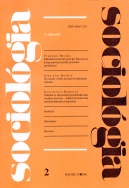Slovenský vidiek na konci dvadsiateho storočia
Slovak Countryside at the End of the 20th Century
Author(s): Stanislav BuchtaSubject(s): Social Sciences
Published by: Sociologický ústav - Slovenská akadémia vied
Keywords: countryside; transformation processes; rural population; unemployment
Summary/Abstract: Slovak Countryside at the End of the 20th Century. The article deals with social changes occurring in the Slovak countryside in connection with transformation processes. It also deals with the impact of these changes on rural population. In the late 20th century, there is an increasing number of houses that are permanently uninhabited, there are changes happening to the settlement structure. Rural population went through internal restructuring towards the end of the last century, the share of inhabitants living in larger rural settlements or near urbanised centres was increasing, and on the other hand, the number of inhabitants living in the smallest settlements was decreasing. Parallel to these changes, the divergence between rural and agricultural, and the agrarian industry is less influencing the rural areas. The rural population is starting to get more socially differentiated. So-called agrarian unemployment arises; it has been firmly established within the rural unemployment structure. In the future development, the labour force having the employee-status will be more and more reduced. On the other hand, other status forms and labour force structures will be gaining higher importance and esteem, especially as to small private farms. The headcount in the agricultural industry will be very variable, cyclic and structurally differentiated. The importance of seasonal labour force, particularly with small-size entrepreneurial subjects, will be growing, and it will be absorbing the groups of inhabitants who are little in demand on the labour force market. There is a renewal of the “seasonal worker” status that was very common in the past; this status is closely connected with a combined income composed of wage and welfare benefits. There are apparent growing trends towards revival of rural areas, towards shifting rural areas into a different social-economical level alongside some indications towards a revival of countryside that are caused by discovering self-evident advantages of rural environment. Sociológia 2003 Vol. 35 (No. 2: 125-140)
Journal: Sociológia - Slovak Sociological Review
- Issue Year: 2003
- Issue No: 2
- Page Range: 125-140
- Page Count: 16
- Language: Slovak

